Click on images to enlarge
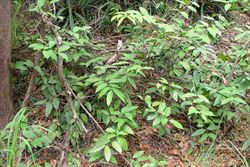
infestation (Photo: Sheldon Navie)

climbing habit in the forest canopy (Photo: Sheldon Navie)
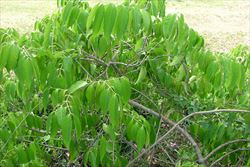
shrubby habit (Photo: Sheldon Navie)
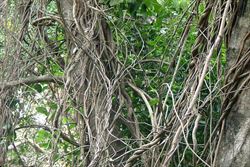
older woody climbing stems (Photo: Sheldon Navie)
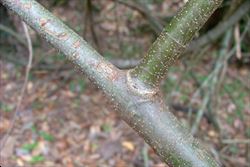
younger branches with lenticels (Photo: Sheldon Navie)
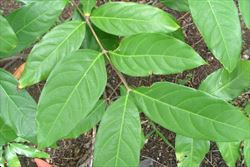
leaves (Photo: Sheldon Navie)
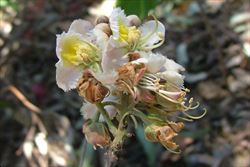
flowers (Photo: Sheldon Navie)
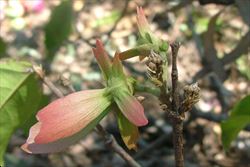
immature fruit (Photo: Sheldon Navie)
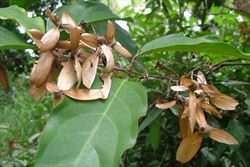
mature fruit (Photo: Sheldon Navie)
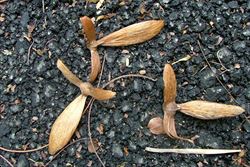
close-up of mature fruit showing their wings (Photo: Sheldon Navie)

close-up of seeds (Photo: Steve Hurst at USDA PLANTS Database)
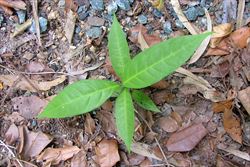
seedling (Photo: Sheldon Navie)
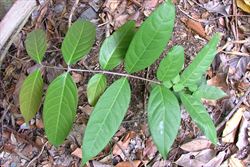
young plant (Photo: Sheldon Navie)
Scientific Name
Hiptage benghalensis (L.) Kurz
Family
Malpighiaceae
Common Names
hiptage
Origin
Hiptage (Hiptage benghalensis) is native to eastern India and south-eastern Asia (i.e. Sri Lanka, southern China, Taiwan, Myanmar, Thailand, Malaysia, Indonesia and the Philippines).
Cultivation
Hiptage (Hiptage benghalensis) has been widely cultivated throughout the world as a garden ornamental, including in the coastal districts of northern and eastern Australia.
Naturalised Distribution
This species has occasionally become naturalised in the coastal districts of south-eastern and northern Queensland. In south-eastern Queensland several small infestations are present in the Brisbane suburbs of Fig Tree Pocket, Toowong and Moggill (mostly near the Brisbane River). It has also been recorded from Currumbin on the Gold Coast and in the Wide Bay pastoral district. In northern Queensland there is a much larger infestation near Mossman.
It is also naturalised in the Mascarenes (i.e. on Mauritius and La Reunion), Hawaii and south-eastern USA (i.e. Florida).
Habitat
Hiptage (Hiptage benghalensis) is most commonly naturalised in closed forests and along waterways, and prefers moist and shady habitats. However, it has also been found growing in suburban gardens, in hedges, and in waste areas (apparently where it has not been deliberately planted). While its distribution is currently quite limited, this species is thought to have the potential to be a problem weed throughout the wetter tropical, sub-tropical and warmer temperate regions of Australia.
Habit
A variable plant and may range from a large woody vine (i.e. liana), climbing up into the forest canopy, to a shrubby plant (particularly when it is regularly pruned in cultivation or not growing under a forest canopy).
Distinguishing Features
-
ranging from a large woody vine with twisting stems to a shrubby plant.
-
its stems have numerous tiny whitish raised spots.
-
its oppositely arranged leaves are somewhat elongated in shape (6-20 cm long and 4-9 cm wide) with duller and paler undersides.
-
its flowers have five whitish petals (1-2 cm long), but one is slightly larger and has a bright yellow centre.
-
its distinctive fruit have three wings (2-6 cm long) and turn pale brown when mature.
Stems and Leaves
The tips of its branches are usually greenish in colour and covered in tiny whitish or yellowish coloured hairs. Young branches are greyish-green in colour and have numerous tiny whitish raised spots (i.e. lenticels). Older stems are greyish-brown and can be quite woody in nature or twisted into very long and thick vines (i.e. lianas).
The simple leaves are oppositely arranged along the stems and borne on short stalks (i.e. petioles) up to 1 cm long. These leaves are relatively large (6-20 cm long and 4-9 cm wide), are usually somewhat elongated in shape (i.e. lanceolate to ovate-lanceolate), and have long-pointed tips (i.e. acute or acuminate apices). Their upper surfaces are bright green and somewhat glossy in appearance, while their undersides are somewhat duller and paler in colour.
Flowers and Fruit
The flowers are fragrant and borne in clusters in the forks of the upper leaves (i.e. in axillary racemes) or at the tips of the branches (i.e. in terminal racemes). Each flower cluster contains 10-30 flowers and can be up to 20 cm long. The individual flowers are borne on short stalks (i.e. pedicels) 15-25 mm long, which have some small bracts on them (each about 3 mm long). The flowers have five sepals (about 8 mm long) that are partially fused together at their bases (i.e. into a calyx tube) and there is a reddish-brown coloured gland (about 4 mm long) near the base of one of these sepals. They also have five rounded (i.e. sub-orbicular to obovate) petals (1-2 cm long) with fringed margins. These petals are white, cream or tinged with pink, but one is slightly larger and has a bright yellow centre. Each flower also has ten stamens that are arranged in two rows. Nine of these stamens have relatively short stalks (i.e. filaments) about 5 mm long, while the other one is much longer (10-12 mm long) and is almost as long as the style (13-15 mm long). Flowering may occur throughout the year, but is most abundant during spring in south-eastern Queensland.
The three-winged fruit of this species are very distinctive (i.e. the fruit is a samara). The wings on the fruit are elongated in shape (2 to 6 cm long) and one of them is usually slightly longer than the other two. The developing fruit are green or reddish-green in colour, but eventually turn pale brown when mature. Each fruit contains 1-3 rounded (i.e. sub-globose) seeds.
Reproduction and Dispersal
This species reproduces mainly by seed. The wings on the fruit enable them to be spread considerable distances by wind, especially when they are released from high in the forest canopy. The fruit may also be dispersed in dumped garden waste or float on water.
Environmental Impact
Hiptage (Hiptage benghalensis) is regarded as an emerging, and potentially significant, environmental weed in Queensland. This species is listed as a priority environmental weed in the Far North Queensland Natural Resource Management region, where it has been targeted for eradication. It is also listed among the top 100 most invasive plant species in south-eastern Queensland, and appears on several local environmental weed lists in this region (e.g. in Redlands, Maroochy and Caboolture Shires).
This highly invasive environmental weed is currently of most concern in the wet tropics bioregion in northern Queensland, where it is considered to pose a significant threat to rainforests and associated ecosystems in the Wet Tropics World Heritage area. It forms impenetrable thickets over forest vegetation and the weight of these vines can cause breakage of supporting trees as well as preventing light reaching the forest understorey. The most serious infestation occurs along several kilometres of the South Mossman River, on the edge of the Mossman Gorge National Park.
It is also reported to have recently become naturalised in riparian vegetation in south-eastern Queensland. In fact, one of these smaller infestations is engulfing many of the native species in remnant riparian vine forest located nearby a single large specimen of the endangered angle-stemmed myrtle (Gossia gonoclada) along a tributary of the Brisbane River. While its distribution is currently quite limited in Australia, this species is thought to have the potential to be invasive throughout the wetter coastal districts of Queensland, north-eastern New South Wales, the northern parts of the Northern Territory and Western Australia.
Hiptage (Hiptage benghalensis) has also become weedy on several islands in the Pacific and Indian Oceans as well as in Florida in the USA. It is has been reported to be particularly invasive on La Reunion and Mauritius in the Mascarene Islands, where it smothers native vegetation and even chokes large trees in natural forests. This species has greatly increased in abundance and distribution in dry lowland forests on La Reunion since 1991 and is also threatening upland forests on Maruitius. Because of its invasiveness it has been included in the Global Invasive Species Database and appears on the list of “100 of the World’s Worst Invasive Species”.
Legislation
Not declared or considered noxious by any state government authorities.
Similar Species
Hiptage (Hiptage benghalensis) is very similar to flame creeper (Combretum paniculatum) when not in flower. However, flame creeper (Combretum paniculatum) can be easily distinguished by its bright red or orange flowers and its four-winged fruit.

